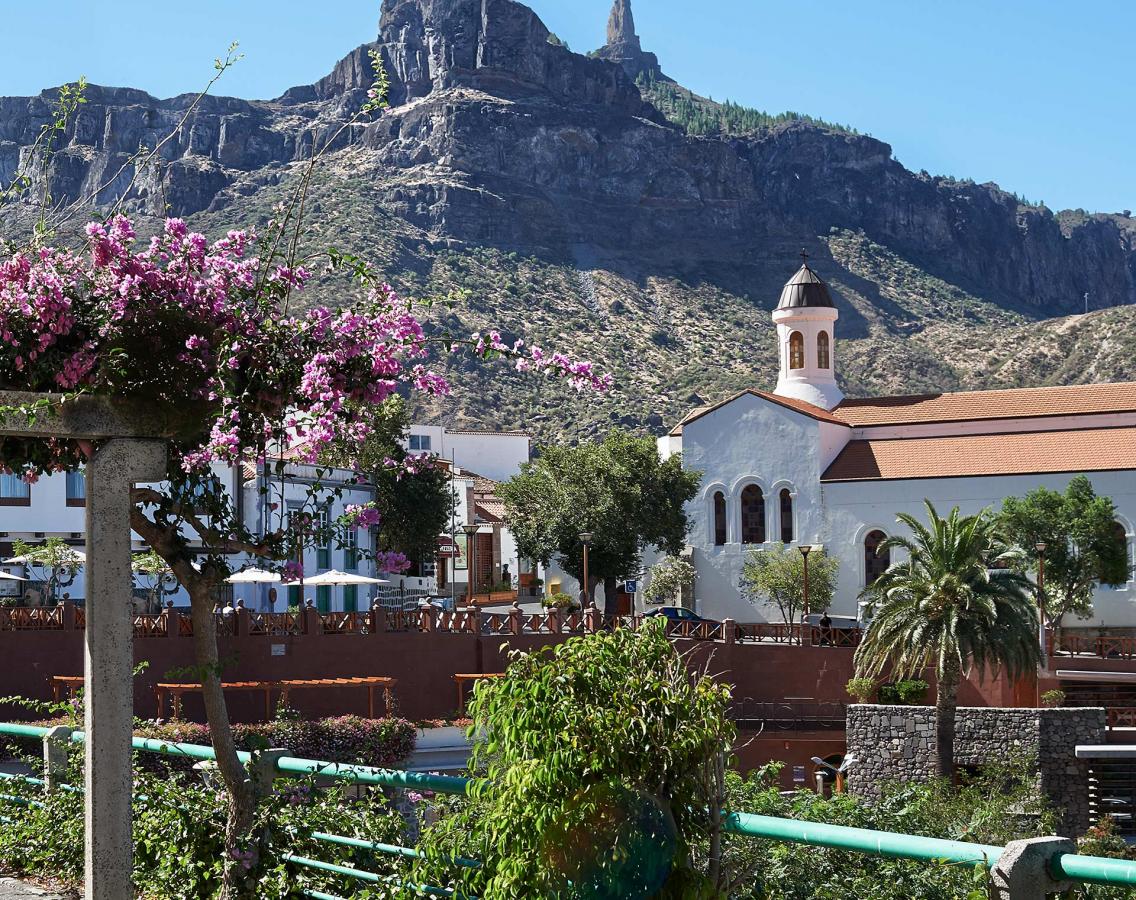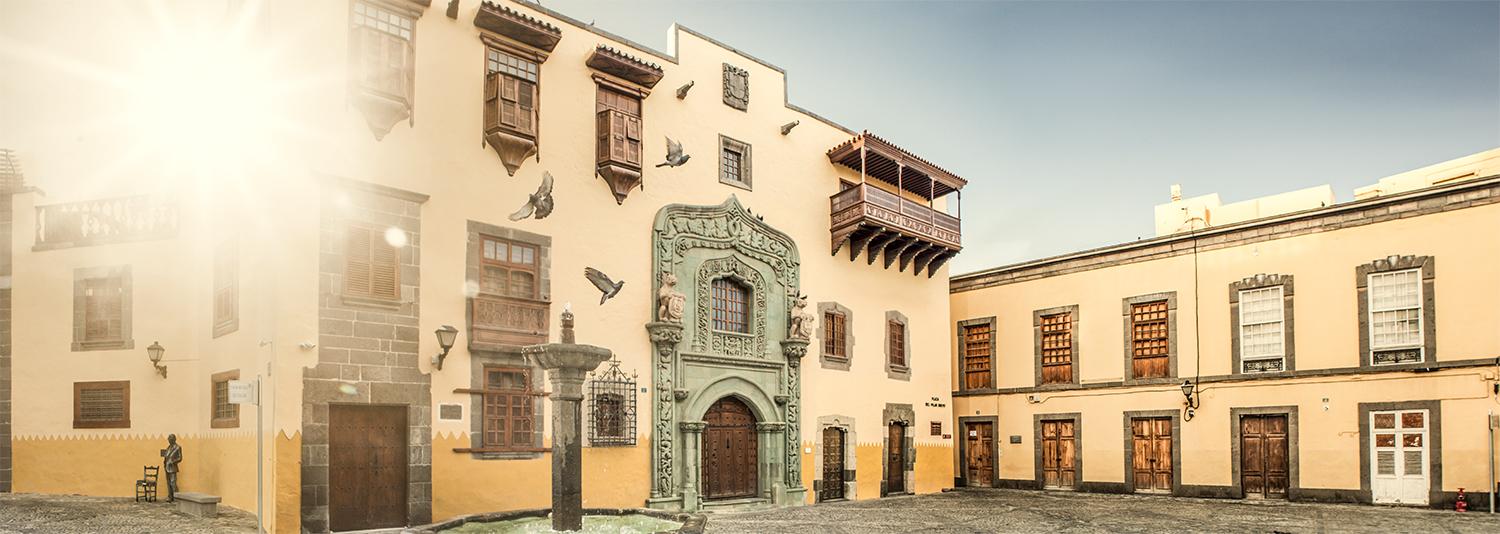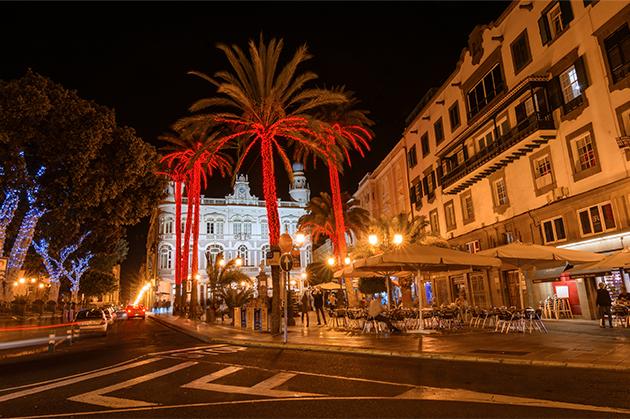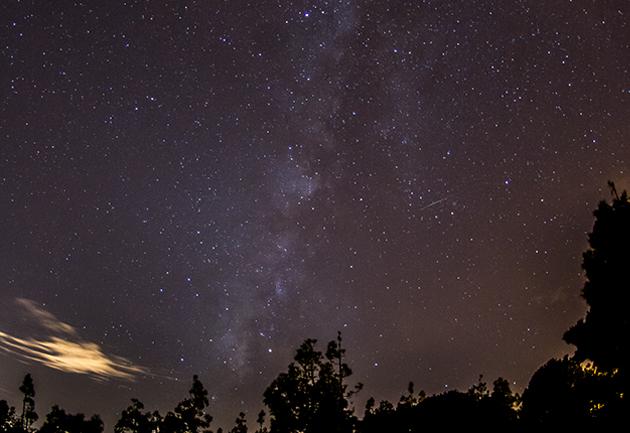Also known as the ‘miniature continent’, Gran Canaria is renowned for its marked contrasts. On a single day, we can enjoy marvellous beaches surrounded by dunes and climb peaks covered in Canary Island pine forests, with their greenery standing out starkly against the dark volcanic earth.
Along the way, we’ll encounter steep ravines, valleys, imposing rocks and volcanic calderas, amazing cliffs… Incredible places we can see from hiking trails, stopping every now and then to look at all the beautiful scenery. Or we can also see the island by car or public transport, as Gran Canaria has an extensive network of well-kept roads.


Just like the other Canary Islands, it is blessed with an enviable climate, an eternal springtime that invites you to experience its rich natural and scenic diversity intensely, its lovely fishing and inland villages, its traditions, culture and history. And also the modernity of the tourist resorts and urban hubs, like Las Palmas de Gran Canaria. The lively, cosmopolitan city is home to one of the most precious gems the island has to offer and that also surprises visitors. Would you like to see it for yourself?
Gran Canaria adds to its incredible offer with a variety of cultural, recreational and sporting activities, as well as a wide array of accommodation, restaurants, shops and well-being centres.
An eternal springtime that invites you to experience its rich natural and scenic diversity intensely, its lovely fishing and inland villages, its traditions, culture and history.
What beach are we going to today?
Without a doubt, the beaches are first on the list of attractions Gran Canaria has to offer. There are enough to suit every taste: large, lively, quiet, coves, with golden or dark sand, or volcanic rock, and… Surprise! The island is home to one of the best urban beaches in Europe.
The biggest beaches are in the south with calm waters and mostly with golden sand. Being near the main tourist areas, they are close to all kinds of services, as well as being easy to access.
The ones in the north are quite different: small coves with dark sand or volcanic rock, more waves, and some that are difficult to reach, although there’s also the option of cooling down in one of the lovely natural pools. These are beautiful, wild beaches, capable of getting us to connect with nature in its purest form.

At the natural heart of the island
Gran Canaria is more than sun and beaches. It’s also nature and beautiful agricultural landscapes, like the one that spreads across the heart of the island, presided by the Roque Nublo, a striking volcanic monolith that can be reached via a trail that is apt for almost everyone. From this natural vantage point, the views are incredible.
The crowning jewel of the grandiose cliffs in the northwest of the island, a landscape known as the ‘dragon’s tail’, is the Tamadaba Natural Park, one of the best preserved primitive Canary Island pine forests in the Canary Islands, along with the one in the Inagua Reserve, which is home to the Gran Canaria blue chaffinch, a small bird that lives exclusively on this island.
These and many other attractions of great scenic value are to be found in the biosphere reserve, a large territory that occupies a significant part of the island’s surface area. The nature, the traditional work done in these areas, the accommodation and the rural tourist activities all coexist under a respectful, sustainable strategy that aims to guarantee their conservation.
Natural and rural spaces, that can be visited thanks to the extensive network of trails crossing the endemic pine forests and ravines alongside large freshwater reservoirs or lava flows… Surroundings in which we also find charming villages and hamlets where we can stop and recover our strength with some of the local cuisine or simply have a chat with friendly, hospitable locals.









Discover delightful villages and hamlets
Far from the lively urban hubs and tourist resorts of the coast, inland Gran Canaria has quiet villages and hamlets where nothing is hurried or rushed. Peaceful and blissful, where the concept of ‘time’ takes on a different meaning, one which lets us connect to a simple life, still rooted in tradition.
One of these places with that special charm is Tejada, the Gran Canaria municipality that is one of the Prettiest Towns in Spain. And there’s a reason for that. Here you’ll find the Cruz de Tejeda National Parador, a modern hotel that is perfectly integrated into the environment and from which we can see one of the prettiest landscapes on the island. Very near Tejeda is Artenara, the highest town in Gran Canaria, right at the entrance to the lush pine forest of Tamadaba.
Other places you have to see are the gorgeous historic quarters of Santa Lucía de Tirajana and Agüimes; or Fataga, with its lush palm grove and whitewashed houses that have preserved the rural architecture of Gran Canaria. Further north, we reach Teror and discover its basilica and beautiful, typical balconies on the houses around the square; and Arucas, whose centre has been declared a site of artistic and historic interest and which houses a magnificent architectural work, the Parish Church of San Juan Bautista, with stonework and wonderful stained-glass windows.
The list of towns and hamlets spread across the island would be never-ending. Exploring them is, without a doubt, the best way to discover the identity and idiosyncrasy of Gran Canaria.
Tejada, the Gran Canaria municipality that is one of the Prettiest Towns in Spain.
On a cultural tour of museums
It’s almost impossible to find a town on the island that doesn’t have at least one museum, although the capital city, Las Palmas de Gran Canaria, offers the widest variety. While walking through the heart of the magnificent historic quarter, you must visit El Museo Canario, which takes us through different aspects of the life of the first settlers, with curious pieces such as a collection of skulls and one of mummies; Casa de Colón (Columbus’s House), a unique building which, as well as bearing testimony to Columbus’s stay in the Canary Islands, shows the history of the islands and their relationship with America; and the CAAM-Atlantic Centre of Modern Art, with exhibitions by European, American and African artists linked to contemporary culture. For fans of technology and science, the Elder Museum is a must-see.

On the rest of the island, we can find astonishing places such as the Casas Cuevas Ethnographic Museum in Artenara, located inside an ancient dwelling that was most likely inhabited by the first settlers. The museum contains furniture and household utensils that are so simple that they bring us back to the modest lifestyle of the past. Other ethnographic establishments are the Museum of History and Traditions in Tejeda which, among other unique items, has a recreation of an old food and general goods shop; and the La Rama Museum in Agaete, which is dedicated to one of the most renowned and popular festivities in the Canary Islands, of the same name, which receives thousands of visitors every summer.
A route that’s the perfect excuse for exploring Gran Canaria and discovering its history and culture.
Discover fascinating archaeological sites
The island has preserved a significant part of its historic and archaeological heritage, allowing us to better understand the culture and way of life of the past inhabitants of Gran Canaria.
A good example would be the cultural landscape of Risco Caído and the Sacred Mountains of Gran Canaria, which have been declared a World Heritage Site, which should give you an idea of how precious these spaces are. It is a large mountainous area in the centre of the island that is home to the traces of a unique cultural process that evolved over the course of 1,500 years with minimal outside influence, from its Berber roots in Northern Africa to the Castilian conquest.
In the north of Gran Canaria, we find an archaeological treasure: the Cueva Pintada Museum and Archaeological Park in Gáldar, a town with more than fifty houses and artificial caves that formed part of a pre-Hispanic settlement. One of the caves contains an exceptional example of wall painting by the original inhabitants. In this area, you can also find the Maipés de Agaete Archaeological Park, a spectacular, enormous field of volcanic rock surrounded by the beauty of the valley that the natives used as a funeral area.
Guayadeque, one of the largest and most beautiful cliffs on the south-east of the island, is of great archaeological value. It has numerous caves that were used by the ancient settlers of Gran Canaria. Another interesting archaeological area is La Fortaleza, which has a visitors’ centre where we can discover things about the daily life of the island’s first settlers, as well as the cave-houses where they lived, a housing model that is still used.
And these are just some of the places that have borne witness to the past and have luckily lasted up to our times, allowing us to learn about, value and respect them.
The Museum and Archaeological Park in Gáldar, a town with more than fifty houses and artificial caves that formed part of a pre-Hispanic settlement.
Pamper yourself on the island of well-being
Gran Canaria is known across Europe as a place that’s good for your health. Since around the 19th century, travellers have come to the island from the continent to recover from all sorts of ailments thanks to its soothing climate. With the passage of time, the concept of rest and recovery has evolved, but revitalisation and the resulting physical and mental well-being are still something the island guarantees.
Sand, sun, sea, fresh air, volcanic rocks, modern treatments and facilities, qualified professionals… Gran Canaria has all you need to pamper yourself, spend some time getting your energy back and return home as good as new, be it at any of the numerous wellness centres that the island has to offer or taking a relaxing evening walk breathing in the sea breeze or the fresh forest air.
Around the 19th century, travellers have come to the island from the continent to recover from all sorts of ailments thanks to its soothing climate.
Do your favourite sport
There is no sport that can’t be enjoyed in this place surrounded by the sea with its year-round spring weather. And with all sorts of facilities and services, there’s no excuse not to spend some time exercising our bodies.
There are infinite options: playing golf on modern courses while enjoying the ocean breeze, getting on a board and battling the waves and wind, riding a mountain bike along the routes especially for them, running along the seashore, swimming in the crystalline waters, climbing mountains that are apt for all levels… It doesn’t matter what shape we’re in. In Gran Canaria, there’s a sport for everyone.






And let’s not forget the nightlife!
The fun and entertainment continue when daylight fades over the island. If you still have a bit of energy, the tourist resorts and capital city have lots to do. There are restaurants, terraces, recreational areas, trendy establishments, cinemas, shows… Lots of ways to also experience the island’s exciting nightlife.
In summer, it’s easy to find a lively local festival in the island’s towns, both on the coast and inland. Although if you’re looking for something quieter, in Gran Canaria, which is a Starlight Tourist Destination, there are astrotourism activities and you can go on a stargazing excursion with a specialist guide.
Don’t leave without trying…
Flor de Guía cheese is a delicacy that is only made in three towns in the north of Gran Canaria. What’s peculiar about it is that it is made from vegetal rennet, which is obtained from the flowers of certain types of thistles. It is one of the Canary Islands cheeses with a protected designation of origin.












